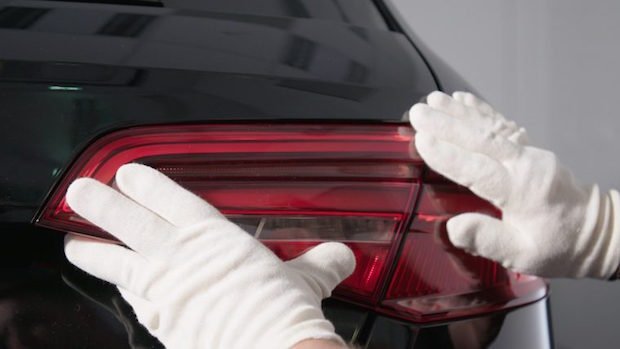Audi, a leading automotive company, has revealed its Pre-Series Center is to adopt Stratasys’ J750 full-colour 3D printer to produce life-like taillight prototypes.
The company has been playing with multiple Stratasys printers for some time – the 3D printing company showcased taillight exhibits made by Audi at formnext powered by TCT 2017 – and has now decided to up the ante by deploying the J750 platform in its Ingolstadt pre-series facility. Audi is confident the machine will bring with it a host of design benefits and, anticipating a 50% reduction in lead times, make the design verification process much shorter.
Audi’s Pre-Series Center is no stranger to polymer 3D printing. It boasts a range of platforms which are used to build physical models and prototypes to allow for design concepts to be evaluated thoroughly. Nearly all the parts that will go into the car are required at this early stage of product development, and because of the time constraints involved with moulding and milling, 3D printing has become an important part of the process. For parts like taillight housings, multi-coloured and made in multiple components that have to be assembled, Audi is now set to enjoy similar advantages. The J750 is capable of printing in over 500,000 different colour combinations, delivering transparency as required for taillights, and doing so all in one piece.
“Design is one of the most important buying decisions for Audi customers, therefore it’s crucial we adhere to supreme quality standards during the design and concept phase of vehicle development,” commented Dr. Tim Spiering, Head of the Audi Plastics 3D Printing Center. “As a result, we need prototypes to have exact part geometries, no distortion and extremely high quality, as well as true-to-part colour and transparency. The Stratasys J750 3D printer will offer us a significant advantage, as it allows us to print the exact textures and colours our design defines. This is essential for getting design concepts approved for production. In terms of 3D printing transparent parts, I have not seen a comparable technology that meets our standards. Using the J750 for the prototyping of taillight covers, we will be able to accelerate our design verification process.”
Dr Spiering leads a team of 24 who share the responsibility of providing 3D printing expertise, advise and production at Audi. The group first began using Stratasys 3D printing technology in 2002 and now has a portfolio of ten systems, including Stratasys FDM and PolyJet platforms. At formnext last year, Stratasys exhibited a taillight housing model printed by Audi with the J750. Previously, it had been using the Fortus 450mc machine, which would take nearly 40 hours to print, and didn’t boast the full-colour, multi-materials capabilities that the J750 does. Now, a taillight assembly takes around 13 hours, and at formnext, the demo piece was printed in vivid magenta, vivid yellow, and vivid clear. At the recent RAPID + TCT, Stratasys was again using it as an example of how beneficial its J750 system can be.
“The level of colour detail we have now in [the J750] system, when you hold that part it looks just like the one they’ve been making for many, many years in traditional means,” Rich Garrity, President, Americas, Stratasys emphasised.
“Lights are the most expensive piece on the car to prototype because they’re so complex,” added Patrick Carey, Senior Vice President, Sales, Stratasys. “You can look at the prototype and the parts, and you can’t tell the difference anymore. Before you could always tell the difference.”
The application of a 3D printing system to taillight prototypes represents an inventive use of the technology, and one that saves time and money too. And that innovative thinking by Spiering’s team in Germany hasn’t gone unnoticed by the Stratasys EMEA President.
“Audi is a prime example of how our unique full colour, multi-material 3D printing technology can combine several design processes into one, rapidly accelerating development cycle,” Andy Middleton offered. “If you extended the time-savings achieved by Audi on the tail lights to other parts of the vehicle, the overall impact on time-to-market can be huge. We’re excited to see how Audi continues to leverage our FDM and PolyJet technologies into new application areas to further increase efficiencies across its development process.”
Article by Sam Davies from TCT Mag online 7th June 2018 – Read it here




